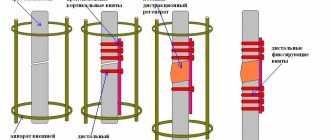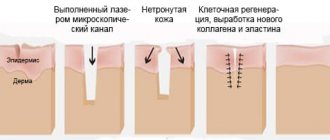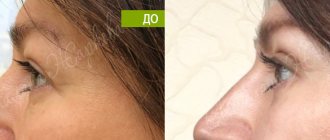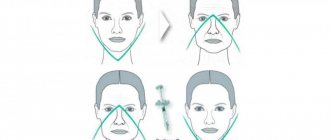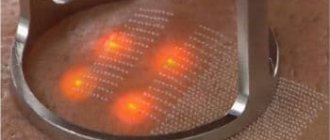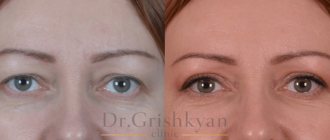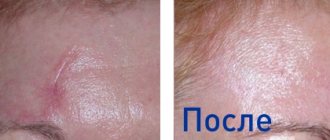How is the procedure for laser coagulation of the veins of the lower extremities performed?
The EVLT procedure is performed on an outpatient basis - the patient usually arrives at the clinic in the morning, and after 2 hours he can leave it. To perform EVLT, the doctor does not need any incisions: a small puncture in the skin is enough, which is done under local anesthesia. Through it, a laser light guide is inserted into the vein.
A light guide is a very thin tube connected at one end to a machine that generates laser waves. Laser radiation is transmitted through it. The light guide moves into the vessel until it reaches the end of the affected area. Then the laser radiation begins to be supplied, and the doctor begins to pull the light guide out of the vein, and as it moves through the vessel, the laser, as it were, “brews” it, seals it. The entire process of insertion and removal of the light guide is controlled using ultrasound, so that the doctor actually “sees” what is happening inside the vein.
The effectiveness of EVLT largely depends on how uniformly the light guide moves inside the vein: coagulation of veins is most effective when all parts of the vessel are “sealed” and not a single affected fragment is missed. Modern EVLC devices allow the optical fiber to be advanced automatically, which ensures greater uniformity.
After the procedure, the puncture is sealed with a plaster; no stitches are required after EVLT.
Preparatory stage
If you plan to treat varicose veins using the endovasal technique, you should not eat before the operation. There are also a number of additional recommendations:
- Undergo laboratory diagnostics: complete blood test, coagulation test, HIV, syphilis, hepatitis.
- Perform an ultrasound of the veins of the lower extremities to assess the state of blood flow.
- Choose compression garments that you will have to wear for up to 5 days after the procedure.
- Shave your legs before the procedure.
Laser photocoagulation of the retina is carried out on an outpatient basis using local anesthesia. Preparation includes the following steps:
- Instillation of a drug into the eyes that dilates the pupil.
- Instillation of anesthetic.
- When the drugs are activated, the coagulation procedure begins.
- Further, the sequence of actions during laser coagulation and the technique of performing the operation depend on the area of application and the volume of vascular damage.
Treatment of superficial vascular pathologies using the percutaneous coagulation method includes the following steps:
- Applying anesthetic cream to the manipulation area.
- Local laser exposure through a special attachment.
An increase in temperature at the level of the vessel walls leads to collapse of the veins. The number of procedures is determined by the amount of exposure required. On average, 3-6 manipulations are performed every 21 days.
Endovasal laser coagulation of dilated varicose veins is performed as follows:
- Introduction of an anesthetic drug to reduce the superficial sensitivity of tissues.
- Piercing a vein affected by varicose veins, followed by introducing a thin laser fiber into the lumen of the vessel.
- Giving an impulse leading to sealing.
The duration of the procedure is about 40 minutes. Subjectively (according to patients), the endovasal technique is well tolerated.
Coagulation of the retina is carried out in the ophthalmology department:
- Placing the patient in a chair after completing the preliminary stage in the form of instillation of an anesthetic and a drug that dilates the pupil.
- Exposure of the retina to the laser for 20 minutes.
Subjectively, there is a sensation of the touch of the lens in combination with bright flashes of light. As a result, bleeding stops or areas of the detached retina are fused. In order to monitor the patient's condition, it is recommended to remain under the supervision of a physician for several hours after the procedure.
For coagulation of newly formed vessels of the cornea, two approaches are used:
- Laser ablation. Under the influence of the beam, there is a restriction of patency in pathologically altered vessels. There is a danger of incorrect impact on nearby tissues with the development of postoperative complications.
- Photodynamic therapy. Preliminary introduction of a photosensitizer that increases the sensitivity of cells to the laser. Its predominant accumulation is observed in the walls of blood vessels. The laser causes a chemical reaction only in those tissues that contain a photosensitizer, preventing the development of negative consequences.
Can complications occur after EVLT?
The method does not cause complications if the patient follows all the doctor’s recommendations, the main one of which concerns wearing compression stockings. It is absolutely necessary after laser coagulation of blood vessels in the legs, so that the walls of the “sealed” vein do not diverge. While the vein is healing, compression hosiery fixes the vessel in the desired position.
The second most important function of compression hosiery is to accelerate the movement of blood through the veins. Due to the special weave of threads and the pressure gradient (difference) that the knitwear creates on the ankle, lower leg and thigh, venous blood flow improves, which helps improve the condition of the veins.
Preparation for the procedure
Before laser coagulation, you must undergo the following set of examinations:
- general and biochemical blood and urine tests;
- coagulogram;
- ECG;
- blood for markers of infectious diseases;
- fluorography;
- examination by a therapist, for women – examination by a gynecologist;
- Ultrasound of peripheral arteries and veins of one limb.
The patient must inform the doctor that he is taking hormonal medications, or, if she is a woman, about the phase of her cycle. Don't neglect such things. Before undergoing the procedure, you must stop taking certain medications (tell your doctor if you are taking hormonal medications). You should also take a hygienic shower and give up bad habits two days before and after the procedure.
It is forbidden to perform hair removal before the procedure, or use creams and lotions. It is advisable to eat 1 hour before the procedure. Following these recommendations will make the procedure as effective as possible.
The doctor must advise and familiarize you with the rules of preparation.
What restrictions are imposed on the patient after EVLT?
We have already mentioned the first limitation: the patient must wear compression stockings, and in the first days after EVLT - two pairs: hospital and everyday. The hospital stockings are then removed and you only need to wear one pair. Considering this feature of treatment, EVLT is usually recommended before the onset of the warm season, when constant wearing of tights or stockings can cause discomfort.
The second limitation concerns lifestyle: after EVLT, it is advisable for the patient to walk more and maintain a certain level of physical activity for 2-4 days (before the follow-up examination).
During the recovery period, you should not do exercises that require stretching or heavy lifting. After one week, you can return to your normal routine, but continue to wear compression stockings and limit heavy lifting for one month. Please note that to further maintain the health of your veins, you need to take care of physical activity. You can do simple exercises at home: after laser coagulation on the veins, exercises such as cycling, birch, scissors, walking or swimming contribute to the health of your legs. The main advantages of laser coagulation of veins for varicose veins are simplicity, efficiency and gentle nature of the manipulation. You don’t need to go to the hospital or take a long time to recover - you maintain physical activity and return to your normal lifestyle with minor restrictions in almost a week.
Main advantages of the procedure
It is worth saying that the procedure has a large number of advantages compared to conventional surgery, namely: minimally invasive and painless; no need for general anesthesia; hospitalization is not required – it is possible to perform the procedure on an outpatient basis; ulcers of a trophic nature can be treated; it is allowed to carry out the manipulation several times; fast recovery period.
The procedure is not performed if the vein is dilated in diameter by more than 10 mm, or if the vein is too tortuous and dilated. The operation will be technically impossible and ultimately ineffective. In addition, this procedure can be used to treat hemangiomas (benign neoplasms of the vascular system) and telangiectasia (“spider veins”).
Treatment is recommended for those patients who have a small number of varicose tributaries, trophic changes in the lower leg due to varicose veins, trophic ulcers, and disruption of the venous valves.
If we talk about contraindications to the procedure, there are a considerable number of them. Most often, the operation has to be canceled or rescheduled due to the presence of inflammatory diseases (especially skin diseases), a history of thrombosis, obesity, infectious, oncological and hematological diseases.
Why is this procedure necessary?
Closing (adhesion) of varicose veins under the influence of laser radiation allows you to quickly normalize blood flow and promptly eliminate dilated vessels.
In this way, a number of problems caused by varicose veins are solved.
A similar technique is used for:
- insignificant volume of varicose tributaries;
- estuarine expansion of the great saphenous vein up to 10 millimeters;
- trophic disorders of the lower leg;
- smooth course of the trunk of the main saphenous veins, etc.
Coagulation of facial vessels
There are two ways to coagulate rosacea vessels. Laser (its cost is higher) and electrocoagulation. The first option consists of using hardware to target the affected vessels with laser beams of various thicknesses and lengths. To completely remove the vascular network on the face, up to 5 sessions will be required. The method is absolutely painless.
Electrocoagulation consists of exposing the problem area to alternating high-frequency currents that cauterize the vascular network. And although such coagulation costs less than laser coagulation, sometimes the doctor has to use local anesthesia. But capillary mesh and stars are removed in just one session.
What is rosacea
Areas on the face with a pronounced vascular network require immediate coagulation of facial vessels. Such damage to capillaries occurs due to disruption of microcirculation of blood flow. This leads to expansion of the capillaries, thinning of their walls and, as a result, fragility.
Cuperosis is not just a dermatological problem. Inelasticity of blood vessels often causes subcutaneous microhemorrhages.
Healthy capillary walls expand and contract easily. If their elasticity is impaired, the skin becomes grayish and inflamed.
Prices:
Laser treatment of vascular pathology
| Removal of capillary hemangiomas on the body: | ||
| 1 mm | 100 rub. | |
| 2 mm | 300 rub. | |
| Removal of hemangioma on the face with a vascular laser | 1,000 rub. | |
| Cheek (one) | 4,000 rub. | |
| Nose wings (both sides) | 1,500 rub. | |
| Full nose | 3,000 rub. | |
| Chin | 3,000 rub. | |
| Single vessel (1 cm) | 1,000 rub. | |
| Local area (1 cm2) | 1,500 rub. | |
Electrocoagulation or laser: which is better?
Advantages and disadvantages of electrocoagulation
If you want to minimize the cost of a cosmetic procedure, use the classic method of getting rid of growths. True, when removing a tumor using electrocoagulation, neighboring tissues will be slightly affected.
Advantages and disadvantages of laser exposure
This is a more modern method. It costs more, but it is carried out precisely and is carried out faster. This applies to both the procedure itself and the healing of tissue after it. As mentioned above, neighboring healthy cells will not be damaged. And most importantly, after electrocoagulation, scars will not appear on the damaged area even after removing large growths.
In addition to the high cost of the procedure, laser coagulation has two more disadvantages, one of which is of fundamental importance. Having eliminated the external imperfection, you will not be able to submit the tumor for analysis, since there will be nothing to send: the tissue will be completely destroyed. This will not happen with electrocoagulation. In addition, not every volumetric growth can be removed with a laser. And if you have dark skin, using a modern device can cause burns.
Conclusion:
There is no clear opinion about what is better to remove moles: electrocoagulation or laser. You choose the answer to this question yourself.
The reception is being conducted
Filatova Elena Alexandrovna
Dermatovenerologist, Cosmetologist
Dermatologist, venereologist, cosmetologist
Levchenko Elena Ilyinichna
Dermatovenerologist, Cosmetologist, Trichologist
Doctor – dermatovenerologist, cosmetologist, trichologist.
If you are concerned about one or more symptoms, you should not hesitate to visit a doctor, since failure to contact a specialist in a timely manner can lead to irreversible processes.
7
Prices for the service
| Coagulation of vascular formations up to 1 cm2 | 1300 | sign up |
| Coagulation of vascular formations up to 4 cm2 | 2600 | sign up |
| Coagulation of vascular formations up to 6 cm2 | 3700 | sign up |
| Coagulation of vascular formations up to 8 cm2. | 5000 | sign up |
| Coagulation of vascular formations up to 10 cm2. | 6000 | sign up |
| Coagulation of vascular formations up to 15 cm2. | 8000 | sign up |
| Coagulation of vascular formations up to 18 cm2. | 10000 | sign up |
| Coagulation of vascular formations up to 30 cm2. | 15000 | sign up |
